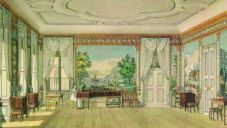The Production and Purpose of the Wallpaper
Scenic wallpapers like Les Sauvages de la Mer Pacifique are landscapes consisting of different panels. Each panel was made by woodblock printing, stencilling and hand brushing, and then glued side by side on all the walls of a room. A person standing in the centre of this room, then, has the impression of being surrounded by a country or urban scene, which helps transport them to a different place and time in their imagination.
Between 1800 and 1855 more than a hundred patterns were produced in factories all throughout France. They enjoyed tremendous success throughout Europe during the 19th century. The printing of these decorations was a real technical tour de force. But since these techniques were common to both the textile and wallpaper trades, panoramic wallpapers were referred to both as papiers peints-paysages (landscape wallpaper-paintings) as well as tableaux-tentures (tapestries). This is also why there was an ongoing debate as to whether scenic wallpapers belonged to the ‘major art’ of painting, or the ‘minor art’ of tapestry. Eventually, due to the complexity of the painterly quality that surfaced in works such as Les Sauvages de la Mer Pacifique, it was considered a ‘major art’.
Most wallpapers represented views of exotic countries, such as India or the Pacific Islands, but sometimes they depicted mythological, military or romantic scenes. As the industrial revolution and advances in sciences disrupted daily life in Western countries, the people who had the money to cover their living rooms with such a panoramic view were able to retreat to this paradise lost and imagine themselves as its master.
